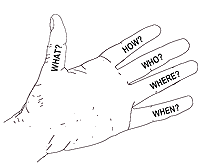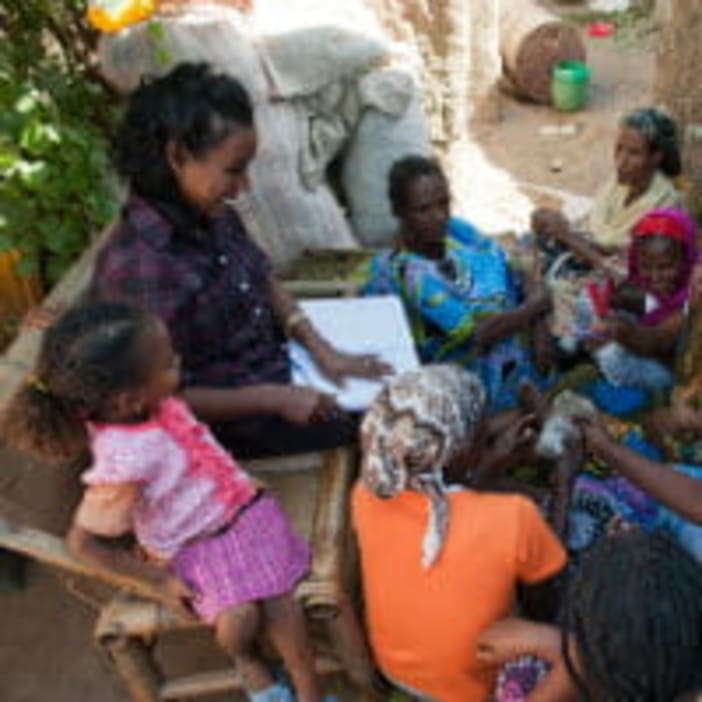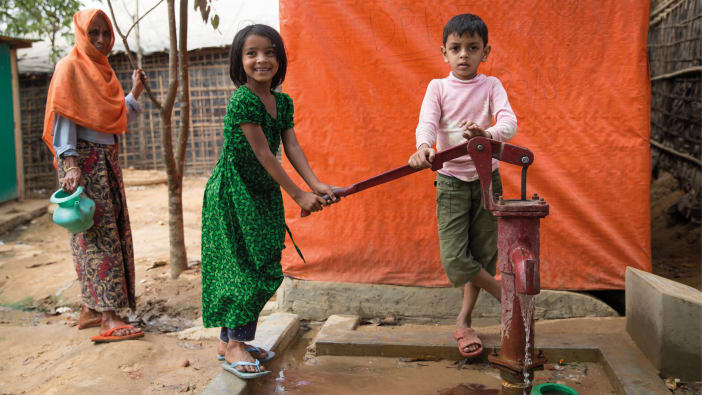WHAT is the task which you are planning? Why is it needed?
HOW is the work going to be carried out? What resources are needed?
WHO is going to carry out this work? Will they need training?
WHERE is the work to be done?
WHEN is the work going to be done? How long will the work take?
Take just one of the tasks from the list and show how these five questions can be used effectively to plan the work. Return people to their original groups and get them to use the Five Finger Questions on another of the tasks in the list of priorities.
Allow time for discussion within the groups and for questions.
Conclusions...
- In each project you must decide with the community the tasks that are needed to carry out the project.
- For every task on the list, ask the Five Finger Questions.
This exercise from The Facilitators’ Manual for the Training of Trainers is used with kind permission of the Uganda CBHC Association.
2. THE PROJECT FRAMEWORK
The project framework aims to encourage careful planning of the project as a whole. Unlike the method above, it also includes monitoring (regular record keeping and adjustment of work) and evaluation (measuring the success of the work). The framework is begun at the start of a project and adjusted if necessary later on. It is useful to display it on a project office wall.
Planning project work in this way is something which donor agencies find very helpful. If your project has never had an overall plan, then it is still not too late to start. Often a project will have more than one phase - a phase could, for example, last three years. A new framework can be planned for each phase. Planning a framework will take time and should ideally involve everyone working in the project from the beginning.
1. Project planning
This is carried out at the beginning of a project.
- First, the aims or wider objectives of the work are agreed.
- Next, decide on the objectives of the project. What benefits will the project bring?
- Now set out the tasks of the project in order of priority (see above).
- List any resources needed by the project.
2. Signs of progress
How will project workers know if work is going according to plan? What sort of signs will indicate progress at different stages? Working out measurable signs of progress will help workers to check on the success of their work later on.
3. Conditions, risks and assumptions
When planning the project work, you will need to assume that certain things (such as funding for salaries) will continue, or that, for example, there will be no epidemic of disease or pests. Think about the things you are taking for granted. It may be decided that the risks are so great the project should not go ahead. Maybe there is a different way of working which involves less risk.
4. Checking progress
This fourth column is filled in at a later stage after work has begun. A reliable guide of success will come from discussions with the community themselves. What has really been achieved? What do they see that has been improved? Has the project really met its objectives? How far-reaching are the effects or results? Complete this column of the framework with the help of the community as well as the project staff.
It is important to realise that the project framework is not a fixed plan. At any stage of the project’s work it may need to be adapted and changed. If, for example, one of the conditions taken for granted fails - such as funding for a vehicle - the project may need to be redesigned. If at a later stage, it becomes clear that one of the aims is not being met, then maybe the objectives of the project need to be changed.
Does all this sound confusing and not appropriate for your kind of work? The table below is an imaginary project framework which may help you to understand the usefulness of this approach.
Worked Example: Framework for a Rabbit Husbandry Project
A health centre has been working in a remote area for several years with some success. However, malnutrition is still a major problem for women and children. There is a lack of small animals which might improve people’s diet. The community have asked for rabbits to be introduced in the area. There is no shortage of fodder and quite a lot of interest in learning about rabbit husbandry. The health centre invite a neighbouring agricultural project to help them plan the work.
Here is the first project framework which they drew up together.
|
|
1. Project Plan |
2. Measurable signs of progress |
3. Conditions, Risks and assumptions |
4. Check on Progress (2 years later) |
|
Wider Project aims |
To improve nutrition of children by adding rabbit meat to family diet |
1 Improved child nutrition
2 Fewer children referred to hospital malnutrition unit |
That most rabbit meat will be used in cooking at home rather than sold |
2 No of children referred reduced from 69 to 45 for local area |
|
Project Objectives |
1 To design and test rabbit housing and husbandry methods for village conditions
2 To train village women as motivators in rabbit production |
1 Rabbit housing in use
2 At least 15 women motivators trained – one per village. Demand for training rabbits in project area |
1 That suitable housing and husbandry methods can be found
2 That motivators pass on skills and knowledge |
1 Housing design seems appropriate-other designs developing in villages
2 All but one village. Project now unable to provide enough stock to meet demand. Motivators also providing stock |
|
Tasks of Project |
1 Employ 2 extension workers
2 Village committees to choose women motivators
3 Team train motivators
4 Build links with rabbit producers in the region
5 Find sources of rabbit stock |
1 Extension workers at work
2 22 women selected
3 team trained and effective in their communities
4 Links and visits set up
5 Sources found. Enough rabbits for meat and breeding |
1-3 Commitment of extension workers and motivators
5 That suitable stock sources can be found. Few diseases and predator problems |
1 Both extension workers still employed
2 18 women completed their training
3 Women’s success with rabbits varied. Some passing information on to others
4 Useful contacts developing-three visits by trainees to other rabbit producers
5 No new stock now being bought in |
Resources |
1 Salaries for two staff
2 Rabbit breeding stock
3 Materials for rabbit housing
4 Two bicycles |
1 Salaries paid
2 Sufficient stock purchased
3 Rabbit housing in use |
1-4 Funding found. Inflation rise within budget
2 Stock will be suited to village conditions |
1-4 no funds remaining. Salaries still being paid – to finish in one year’s time
4 Bicycles still in good order |
EVALUATION After two years they spent some time with the community, evaluating the success of their work (the results are shown in column four). It was apparent that many rabbits were being sold for their meat and fur rather than being eaten in local homes. It was decided that the overall aim should include improving household income as well as encouraging better nutrition. Teaching about buying food for better nutrition was introduced.
Funding was to be reduced - no new money would be available for salaries - a small amount would be available for new stock, bicycles and building materials. New rabbit breeding stock would be needed to prevent in-breeding. The trained women motivators should now be encouraged to pass on their skills in rabbit husbandry to others. The project needs to become self sufficient within two years.
A re-designed framework would now be needed for the next two years. As a group exercise, write out a new project framework.










